The photograph of Rita Hayworth at a nightclub in the early 1940s offers more than a mere glimpse into a glamorous evening; it captures a critical juncture in American cultural history. At the intersection of celebrity construction, gender representation, and wartime psychology, Hayworth’s image crystallizes the era’s yearnings, ideals, and contradictions.
Born Margarita Carmen Cansino, Hayworth’s transformation into the epitome of American glamour was neither accidental nor organic. It was meticulously engineered by Columbia Pictures and its head, Harry Cohn, who saw in her a raw material that, if refined, could rival the established star power of MGM and Warner Bros.
Central to this transformation was the recalibration of her ethnic identity. By raising her hairline through painful electrolysis and dyeing her naturally dark hair red, Hayworth was physically reshaped into a palatable vision of Anglo-American beauty standards — an act of cultural erasure that speaks volumes about Hollywood’s racial politics.
The nightclub scene captures this reconstructed identity in full bloom. It is not Margarita Cansino the dancer but Rita Hayworth the star who looks out from the photograph.
Her body language, her gown, the lighting — all operate within the visual grammar of stardom carefully codified by studio photographers and gossip columnists.
Yet, there is something distinctly human beneath the veneer: a glint of knowingness in the eyes, a slight tension in posture, as if she were keenly aware of the performance that being Rita Hayworth demanded.
The 1940s Nightclub as Stage and Symbol
Nightclubs in the 1940s were not mere venues for recreation. They were informal stages where the dramas of celebrity were both rehearsed and performed. Hollywood’s leading men and women were expected to be seen, their presence simultaneously authentic and orchestrated. To be photographed at a nightclub, glass in hand, laughter frozen mid-air, was to assert one’s relevance in the intricate theater of fame.
In wartime America, nightclubs acquired an added symbolic charge. They became emblems of what was being defended — the good life, the liberty to dress extravagantly, to dance, to drink, to live freely under the bright lights of democracy. Against the backdrop of rationing, grief, and uncertainty, images of figures like Hayworth in shimmering gowns functioned as morale-boosting fantasies. They offered an escape into a parallel world where beauty endured unblemished.
Hayworth, perhaps more than any of her contemporaries, became synonymous with this fantasy. Her rise to fame during World War II coincided with the psychological need for icons who embodied resilience without seeming burdened by it. She was neither the hard-boiled femme fatale nor the girl-next-door ingénue; she was something rarer — a figure who could be both accessible and unattainable.
Gender, Desire, and the Performance of Glamour
The nightclub photograph, viewed through a contemporary lens, underscores the performative nature of femininity in mid-century America. Hayworth’s beauty was not passive; it was an active labor, involving not only physical transformation but also an unceasing emotional choreography — the smile that must seem spontaneous, the glance that must appear unstudied. It was a labor expected of women at large: the need to construct and maintain an image acceptable to the male gaze while masking the exertion behind it.
Hayworth’s persona was steeped in the dialectic of desire and inaccessibility. In the 1946 film Gilda, when she famously peels off her gloves in a striptease that reveals almost nothing yet suggests everything, she perfected the aesthetic she had honed in real life. The nightclub photograph anticipates this performance. Even at rest, Hayworth embodies a kind of poised seduction — inviting enough to draw the gaze, remote enough to remain untouchable.
Her portrayal aligned with evolving ideas about women’s roles in wartime society. As men went overseas, women entered factories, donned uniforms, and temporarily stepped outside traditional domestic roles. Hayworth, with her blend of sensuality and strength, mirrored these shifts. Yet the glamour industry also reassured a nervous populace that femininity, as they understood it, would survive the upheavals of war.
Fame, Myth, and the Manufacturing of Memory
The nightclub photograph is also an artifact of the mechanisms through which Hollywood manufactured memory. Photographs like these were widely disseminated through fan magazines, newsreels, and advertising, becoming part of the collective visual vocabulary of the period. They were curated images, carefully staged to maintain a delicate balance between aspiration and relatability.
But they also fed into a broader process of mythmaking. Hayworth’s public image, particularly after her performance in Cover Girl (1944), was idealized to the point where the woman herself was obscured. Orson Welles, her second husband, famously remarked that he married Rita Hayworth but woke up with Margarita Cansino — a statement that speaks less to Hayworth’s duplicity than to the absurd expectations placed on women who inhabited public fantasies.
The nightclub image, framed by soft lighting and exuberant decor, becomes not a record of a real moment but a tableau vivant — a living painting curated to survive the ravages of time. It is a piece of commercial art that, paradoxically, now holds historical value precisely because it is artificial.
Wartime Morale and the Soldier’s Pin-Up
Another layer of significance stems from Hayworth’s role as the most popular pin-up girl of World War II. Her image famously adorned the atomic bomb “Gilda,” dropped on Bikini Atoll during postwar tests — a chilling testament to how deeply ingrained she had become in the American consciousness.
Photographs like the nightclub scene were integral to this process. They reinforced Hayworth’s status not just as a movie star but as a symbolic embodiment of everything soldiers believed they were fighting for — beauty, freedom, the possibility of a joyous future. The accessibility of the nightclub — compared to a movie set — made it seem as if Hayworth’s world was within reach, even if, in reality, it was anything but.
The tension between fantasy and reality in these images helped define the psychological landscape of mid-century America. They offered catharsis without disruption, pleasure without consequence, hope without the burden of probability.
Postwar Disillusionment and the Erosion of the Myth
After the war, America’s relationship with its icons grew more complicated. As prosperity returned, so too did a heightened scrutiny of celebrity. Scandals that would have been buried in the 1940s came to light in the tabloid culture of the 1950s. Hayworth’s personal struggles — troubled marriages, battles with alcoholism, and eventual descent into Alzheimer’s disease — contrasted sharply with the flawless image presented in nightclub photographs and movie posters.
And yet, the photograph endures precisely because it freezes her in time, impervious to decline. It is a preservation of not only Hayworth’s image but also the cultural moment that produced it. It speaks to the way America, at mid-century, needed to believe in beauty as something eternal, even as the realities of politics, war, and human frailty suggested otherwise.
Impression
The photograph of Rita Hayworth at a nightclub circa 1940 is not simply a record of a beautiful woman at the height of her powers. It is a layered cultural document — a palimpsest upon which issues of identity, performance, gender, and national myth are inscribed.
It reminds us that glamour is not trivial. It is a language through which societies articulate their deepest desires and anxieties. Hayworth’s poised smile, the gleam of her dress, the ambient glow of the nightclub — all these elements converge to create a vision of an idealized America, one that remains powerful precisely because it was never real.
No comments yet.








